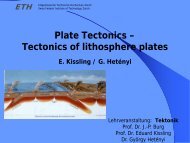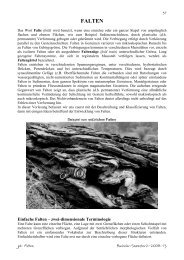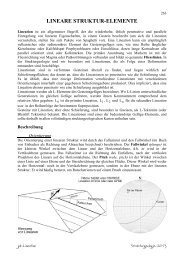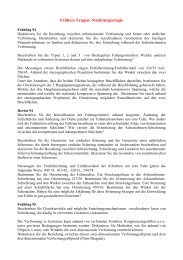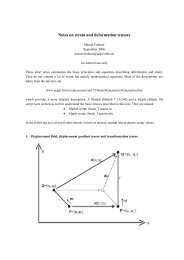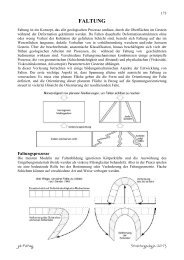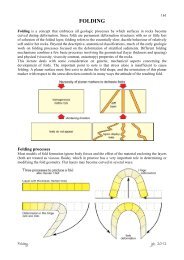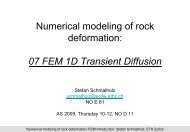STRIKE-SLIP AND OBLIQUE-SLIP TECTONICS
STRIKE-SLIP AND OBLIQUE-SLIP TECTONICS
STRIKE-SLIP AND OBLIQUE-SLIP TECTONICS
Create successful ePaper yourself
Turn your PDF publications into a flip-book with our unique Google optimized e-Paper software.
<strong>STRIKE</strong>-<strong>SLIP</strong> <strong>AND</strong> <strong>OBLIQUE</strong>-<strong>SLIP</strong> <strong>TECTONICS</strong><br />
Strike–slip faulting is a common mode of deformation in both continental and oceanic crust and<br />
occurs at a wide range of scales. Strike slip systems are relatively narrow and subvertical wrench<br />
zones along which two adjacent blocks move sideways, horizontally, parallel to the strike of the<br />
fault zone. For example, they are produced at transform plate boundaries where plates horizontally<br />
slide past one another. There is no net addition or subtraction of area to the crust. It is classically<br />
accepted that strike slip faulting occurs in a triaxial stress field in which the maximum and<br />
minimum principal stresses σ1 and σ3 lay in the horizontal plane and the intermediate principal<br />
stress σ2 is vertical. In a trigonometric system, a strike slip fault at an angle 0 < θ < 90° to σ1 is<br />
sinistral; it is dextral if 90 < θ 22°) to the<br />
boundary normal. 14% of plate boundaries have vectors nearly parallel to boundaries (within 22°).<br />
This implies that strike-slip tectonics is important, whether alone or as a component. Present-day<br />
plate tectonics document four main types of strike-slip systems:<br />
Conservative plate boundaries<br />
Transform fault at oceanic plate boundaries Mid-Atlantic ridge<br />
Transform fault at continental plate boundaries Basin and Range<br />
Passive margins Bay of Biscay<br />
Tectonics – Strike-slip faults jpb-2013<br />
157
158<br />
Destructive plate boundaries with oblique convergence<br />
Transpression at continental plate boundaries New Zealand, California<br />
Constructive plate boundaries with oblique extension<br />
Back-arc basins Philippines, the Kuril Archipelago<br />
Intra-plate strike slip faults<br />
Tectonic escape Asien<br />
Transtension Mid-Atlantic ridge<br />
In general, the strike-slip tectonic regime is characterized by feeble magmatic and metamorphic<br />
activity.<br />
GEOMETRIC RULES OF <strong>STRIKE</strong> <strong>SLIP</strong> FAULTING<br />
Strike-slip fault systems are usually narrower and more continuous than either compression or<br />
extension systems. At depth strike slip zones become ductile shear zones characterised by vertical<br />
foliation and a horizontal stretching lineation (e.g. the South Armorican Shear Zone). They can be<br />
several kilometres wide.<br />
Basic terminology<br />
Strike-slip faults are generally vertical faults that accommodate horizontal shear within the crust.<br />
The horizontal displacement is either dextral (clockwise), or sinistral (anticlockwise).<br />
Symbols in sections are circles, with a point (tip of the arrow) on the block moving towards the<br />
observer, and a cross (back-end of the arrow) on the block moving away from the observer.<br />
Remember: A fault is sinistral if, to an observer standing on one block and facing<br />
the other, the opposite block appears to have been displaced to his left.<br />
Conversely, the fault is dextral if the movement is to the right.<br />
A scissor fault changes dip and offset sense along strike so that the hanging-wall becomes the<br />
footwall.<br />
Tip line; branch line; cut-off line<br />
These geometrical features have the same definitions as for other fault types. Tip lines are isolated<br />
ends of fault segments.<br />
Subsidiary fractures = Riedel shears<br />
Subsidiary shear fractures that propagate a short distance out of the main fault but are coeval with it<br />
are called Riedel shears. This term is also used on a large-scale fault pattern and may refer to as<br />
many as five direction families of associated fractures. In that case, individual fractures remain<br />
active after the other types developed so that synchronous movement on all fractures accommodate<br />
strain in the fault zone. The geometrical arrangement of Riedel shears is indicative of the sense of<br />
Tectonics – Strike-slip faults jpb-2013
159<br />
movement within the wrench zone and is therefore widely used for the interpretation of its<br />
kinematic evolution.<br />
- R Riedel shears are generally the first subsidiary fractures to occur and generally build the<br />
most prominent set. They develop at an acute angle, typically 10-20° clockwise to a dextral main<br />
fault, anticlockwise to a sinistral strike-slip fault. They often form an en échelon and overstepping<br />
array synthetic to the main fault; they evolve as a sequence of linked displacement surfaces. Their<br />
acute angle with the fault points in the direction of the relative sense of movement on the main<br />
fault. This angle is equal to φ 2 , where φ is the material internal friction angle.<br />
- R’ shears are antithetic faults (i.e. with a sense of displacement opposite to the bulk<br />
movement) oriented at a high angle (approximately 75°, i.e. 90°−( φ 2)<br />
clockwise to a dextral,<br />
anticlockwise to a sinistral main fault plane), conjugate with the R(iedel) shears. They<br />
preferentially occur in the overlap zone between two parallel R shears and often connect these two<br />
R shears. They may develop with or after R shears.<br />
- P shears are synthetic minor faults symmetrically oriented to the R shears with respect to<br />
the fault plane (at φ 2 from the fault plane, anticlockwise and clockwise to dextral and sinistral<br />
faults, respectively). P shears also form an en échelon array contemporaneous with R shears or later<br />
as links between R shears. P-shears are contractional and accommodate fault parallel shortening as<br />
shearing proceeds. They are less common as R and R’ shears and may require more displacement to<br />
form. As for R Riedel shears, there may be P’ shears conjugate with P shears but these have<br />
relative minor importance and are difficult to separate, in terms of orientation, from R-shears.<br />
- Y shears are synthetic microfaults sub parallel to the main fault, apparently the last to form.<br />
Riedel microfaults may all connect one another to form an anastomosing network of fractures in a<br />
narrow fault zone whose bulk borders are parallel to the main fault. Complications are introduced<br />
when Riedel-within-Riedel shears form.<br />
Strike slip trajectory; Map trace<br />
Because slip is horizontal and parallel to the commonly straight fault trace, the kinematics and<br />
mechanics of strike–slip faulting are well displayed from maps. A perfectly planar strike-slip fault<br />
causes neither extension nor shortening; consequently there is no associated topography. However,<br />
long strike slip faults follow a staircase-like trajectory made up of alternating long and a straight<br />
trace (vertical equivalent to flats) connected by oblique bends or jogs (vertical equivalent to ramps).<br />
Tectonics – Strike-slip faults jpb-2013
160<br />
The resulting undulation of fault-surfaces is also documented by 3D seismic and remote-sensed<br />
data and. The wavy shape is attributed to linkage of fault-segments through time.<br />
Linkage<br />
Strike slip faults are commonly segmented at all scales and levels of exposure, typically in the form<br />
of en échelon, non-coplanar faults separated by offsets (or step-overs). These step-over zones of<br />
host rock between the end and the beginning of two adjoining en échelon shear fractures deform in<br />
order to accommodate continued strike slip displacement. This local deformation may lead to the<br />
formation of short fault segments that connect adjacent en échelon fault segments and result in a<br />
through-going fault zone. The geometry of these step-over zones and linking faults, in turn, controls<br />
contractional or extensional deformation according to the sense of slip and stepping direction of the<br />
en échelon fault segments.<br />
Left-stepping refers to the arrangement in which one fault segment occurs to the left of the<br />
adjacent segment from which it is being viewed. The contrary is right-stepping. Hard-linkage<br />
occurs where faults directly link together. Soft-linkage occurs where strained zones without<br />
through-going fault link individual fault segments.<br />
- Contractional or restraining bends and offsets are local zones of convergence where material<br />
is pushed together by the dominant fault movement. The linkage of adjacent fault segments is<br />
typically through the development of P-shear splay faults. At a constant volume of the<br />
deforming transpression zone, local shortening will produce vertical lengthening and thus<br />
surface uplift. This push-up area will be eroded.<br />
- Extensional, releasing or dilatant bends and offsets are local zones of extension where material<br />
is pulled apart by the dominant fault movement. The linkage of adjacent fault segments is<br />
typically through the development of R-shear splay faults. At a constant volume of the<br />
deforming transtension zone, local extension will produce vertical shortening and surface<br />
depression. This pull-apart area will be site for sedimentation.<br />
A strike-slip fault system commonly shows a braided pattern of anastomosing contemporaneous<br />
faults. Contractional and extensional bends and offsets can thus alternate along a single yet<br />
complex strike-slip zone.<br />
Tectonics – Strike-slip faults jpb-2013
Strike-slip duplexes<br />
Multiple linking of closely-spaced R- and P-shears may create fault-bound lenses (elongate horses)<br />
imbricated between overlapping en échelon segments. Such sets of horizontally stacked and<br />
isolated rock lenses are bounded on both sides by parallel segments of the main fault and thus<br />
define strike-slip duplexes (like thrust or normal-fault duplexes, but tilted to the vertical). They<br />
develop in transfer zones, where displacement is conveyed from one fault segment to another in<br />
systems of stepped strike-slip faults, and in bends, where the orientation of the main fault is<br />
deflected.<br />
Strike-slip duplexes may be compressional or extensional, depending on whether they formed at an<br />
extensional (facing towards the movement direction) or contractional (facing against the relative<br />
movement) bend. Thrust or normal-fault duplexes accommodate vertical thickening (through<br />
stacking of vertical slabs that rise upward and outward over the adjacent blocks) or thinning<br />
(through separation of horses) of the crust. For strike-slip duplexes, the corresponding thickening or<br />
thinning would have to occur in a horizontal direction, which is difficult owing to the constraint<br />
imposed by the rest of the crust. The required deformation can be easier accommodated vertically,<br />
and, therefore, strike-slip duplexes involve oblique movements. In a compressional strike-slip<br />
duplex, fault must combine strike- and reverse slip; in an extensional strike-slip duplex, faults<br />
combine strike- and normal slip.<br />
Rotation of horses around a horizontal axis may produce scissor-faults, which change from a<br />
normal fault at one end to a reverse fault at the other. Duplexes are commonly breached by faults<br />
that connect the stepping segments.<br />
Tectonics – Strike-slip faults jpb-2013<br />
161
162<br />
In large systems, pieces (horses or sidewall ripouts) from one side of the main fault may be sliced<br />
off and transferred to the other side as the active fault takes a new course. This may produce fartravelled<br />
blocks that are exotic to the block with which they are associated. Blocks of this type have<br />
been transported to considerable distance from their sites of origin; they are termed displaced or<br />
exotic terranes.<br />
Horsetail splay<br />
Like any other fault, strike-slip faults may terminate in zones of ductile deformation. In brittle<br />
terminations, the displacement is distributed through several branching splay faults. These small<br />
faults, curved away from the strike of the main fault, form an open, imbricate fan called a horsetail<br />
splay.<br />
Antithetic and synthetic splay faults at tips of major strike slip faults have often a small vertical<br />
component consistent with the extensional or compressional character of the fault termination.<br />
Large-scale, extensional horsetail splays may host sedimentary basins at tips of major strike-slip<br />
faults. Conversely, compressional horsetail splays may display thrust faults and folds at tips of<br />
major strike-slip faults.<br />
Map-view geometrical complexity<br />
Strike slip faulting in the basement may not cut through the cover. Instead, the bulk cover<br />
displacement is distributed among sets of structures in a long and narrow wrench-zone, parallel to<br />
and over the basement strike-slip fault. The geometrical complexity of the wrench zone reflects a<br />
bulk strain that combines pure shear across the strike slip faults, and simple shear parallel to the<br />
strike-slip faults. The pure shear component arises from the compressional or extensional<br />
component across the zone, and the simple shear component from the strike-slip displacement. For<br />
infinitesimal simple shear of an idealized homogeneous body, the strike-slip zone boundary is a line<br />
of no extension. The directions of instantaneous extension and compression are given by the<br />
orientation of the horizontal strain-ellipse and are predicted to occur at 45° to the strike-slip zone<br />
boundary. Because the earth’s surface is easily deformed, various types of structures may form<br />
simultaneously, according to their orientation with respect to the ellipse orientation.<br />
Tectonics – Strike-slip faults jpb-2013
- Folds and thrusts form parallel to the ellipse long axis, typically in en échelon arrays whose<br />
acute angle to the main fault is opened in the direction of shear.<br />
- Normal fault and tension fractures are parallel to the ellipse small axis, typically in en échelon<br />
arrays whose acute angle to the main fault is opened in the direction opposite to that of shear.<br />
The orientation of these structures will depend on the intensity of transpression or transtension.<br />
- Conjugate sets of strike-slip faults form oblique to the main fault (synthetic and antithetic<br />
Riedel shears, i.e. with the same and opposite sense of displacement as the master fault,<br />
respectively).<br />
In reality, progressive general shear is likely to result in the folding and rotation of faults soon after<br />
their initiation. Besides, pre-existing structures are reoriented and eventually destroyed, while new<br />
folds and faults are growing.<br />
Transpression and transtension<br />
Transpression means that shortening is taking place across a dominantly strike-slip fault (oblique<br />
convergence, like along the San Andreas Fault Zone). Conversely, transtension means that<br />
extension is a deformation component of bulk strike-slip faulting (California Gulf).<br />
Tectonics – Strike-slip faults jpb-2013<br />
163
164<br />
Combined yet usually partitioned slip components refer to particular boundary conditions at the<br />
regional scale such as oblique convergence or divergence at plate margins, or to local conditions as<br />
in restraining (in compression) or releasing (in extension) bends.<br />
Transpression and transtension are defined by the angle α between the fault zone and the<br />
horizontal, convergence or extension direction, respectively. Experimental results show a sharp<br />
contrast between structures formed at α ≤ 15° and α ≤ 30°. For small values of α , deformation is<br />
localised on steep faults (dipping > 70°) and structures are typical of strike-slip regime with Riedel<br />
faults. For high α deformation is more distributed on shallow dipping faults that build asymmetric<br />
uplift zones on thrusts or basins on normal faults, according to the regime.<br />
Flower structures<br />
Seismic profiles across main faults of transpressive and transtensive strike-slip duplexes have<br />
revealed the following characteristics:<br />
- Fan-like, rather steep faults converge at depth into a single and subvertical fault.<br />
- The deep main fault (the stem) is subvertical.<br />
- Facies and thickness strongly vary for a same stratigraphic layer on both sides of faults.<br />
- Normal and reverse offsets along a single fault plane often result from inversion of the relative<br />
movement on the fault.<br />
This upward splay shape of subsidiary faults is termed a flower structure.<br />
- If the vertical component is normal, faults tend to be listric and to form a normal or negative<br />
flower structure, which forms a depressed area. This subsiding, commonly synformal area has<br />
generally, in map-view, a wedge- or a rhomb-shape. It forms a sagpond, a rhomb graben or,<br />
on a larger scale, a pull-apart basin. Negative flower structures are also called tulip<br />
structures.<br />
- If the vertical component is reverse, the splay faults tend to be convex upward, with gentle dips<br />
at the surface. They form a reverse or positive flower structure, which appears as an uplifted,<br />
commonly antiformal area (a rhomb horst or push-up). Positive flower structures are also<br />
termed palm-tree structures, owing to the convex upward form of the upward-diverging faults.<br />
Tectonics – Strike-slip faults jpb-2013
Sections of flower structures display strong variations along the same wrench system.<br />
Strike slip faulting<br />
Models using analogue materials such as clay and sand have revealed a fairly consistent faulting<br />
sequence in experimental strike-slip fault zones. Fault zones usually begin with a set of relatively<br />
short R-shears arranged in en échelon arrays and coeval with minor, conjugate R’-shears. With<br />
further deformation, R’ shears connect propagating and overlapping R-shears while P-shears begin<br />
to form. Then, linkage of R-, R’- and P-shears, imbrication and duplexing of the resulting rhombshaped<br />
blocks combine to give a through-going but irregular fault zone consisting essentially of<br />
alternating R-shear and P-shear segments, synthetic to the sense of movement on the major fault.<br />
The differences in orientation of these segments relative to the overall slip direction means that the<br />
P-shear linkages are in restraining orientations for continued displacements. Further strike slip<br />
faulting may involve the modification of these restraining sections through both abrasive and<br />
adhesive Y-shear wears to form a more planar, through-going fault zone.<br />
In theory all shear surfaces can occur and slip together but analogue experiments show that they<br />
mostly develop in different places at different times. Only some segments or splay faults are active<br />
at any one time. Faults can be dormant for considerable periods. This leads to complex and repeated<br />
reactivation of faults and fault segments leading to complex structure and stratigraphy.<br />
Tectonics – Strike-slip faults jpb-2013<br />
165
166<br />
Relationship between folds and strike-slip faults<br />
Passive en échelon folds<br />
Folds associated to wrench fault systems are typically non-cylindrical, doubly plunging and<br />
relatively short with steeply dipping axial planes. They are arranged spatially such that<br />
culminations and depressions in successive folds lie along lines that make an acute angle with the<br />
approximately parallel fold axes. Such folds are stepped, consistently overlapping, and said to be<br />
arranged en échelon. Taking the axial planes as roughly orthogonal to the shortening direction, their<br />
distribution permits to decipher the potential strike-slip fault they are related to. Such folds are<br />
common above strike slip faults in the basement, which have not broken the cover. The en échelon<br />
folding reveals the relative sense of movement.<br />
Local strike-slip faults associated with other structures<br />
Local strike-slip faults occur in the hanging wall blocks of low-angle faults and accommodate<br />
different amounts of displacement either on different parts of the fault or between the allochthonous<br />
and adjacent autochthonous rocks. They are common in deforming regions that are detached from<br />
lower levels (e.g. in foreland fold-and-thrust belts). In this case, local strike slip faults die out<br />
downwards on a décollement that separates the deformed cover from the underlying basement.<br />
Transfer fault<br />
A transfer fault is a strike slip fault that transfers displacement between two similar non-coplanar<br />
structures (e.g. in step-overs between two normal or thrust faults). It is striking parallel to the<br />
regional direction of extension or compression. The transfer fault terminates on these two other<br />
structures and is also known as lateral ramp. It is a local and passive fracture formed in response to<br />
active faulting on faults which link with the transfer. Hence, transfer faults can reverse their strikeslip<br />
sense in time and space and may show apparent offsets opposite to the true movement sense.<br />
Tectonics – Strike-slip faults jpb-2013
Tear fault<br />
A tear fault is a relatively small strike slip fault that runs across the strike of a contractional or<br />
extensional belt and accommodates differential displacement between two adjacent segments of the<br />
belt. Tear faults are therefore parallel to the movement direction of thrusts or normal faults; they are<br />
usually common in hanging walls of low-angle faults. Fold axes, where folding is involved, tend to<br />
terminate against tear faults.<br />
LARGE-SCALE ANALYSIS OF <strong>STRIKE</strong>-<strong>SLIP</strong> SYSTEMS<br />
Strike-slip tectonics characterises the mature stages of orogenic belts. For example, escape tectonics<br />
in Asia occurred only late in the India-Asia collision. Similarly, there was lateral extrusion of<br />
Northwest Europe away from the North-African indentor well after the Variscan collision.<br />
General features<br />
Steeply dipping transcurrent fault zones and shear zones absorb the mechanical effects of stresses<br />
generated during the frictional move. Characteristically, deformed rocks have steep foliations and<br />
sub-horizontal lineation.<br />
Transform faults are strike-slip faults at plate boundaries, parallel to the direction of relative<br />
motion of the plates on either side. They include transfer faults along which plates slide past each<br />
other, but the kind of motion between plates is changed at the end of the fault. For example, the<br />
transform fault may connect convergent and divergent plate boundaries, or trenches to trenches,<br />
etc... Such transform faults finish at a point where the strike slip movement is transformed into the<br />
corresponding convergence or divergence.<br />
Accordingly, there are three basic types of transform faults that are extended to six more specific<br />
types:<br />
Type Example<br />
(1) Ridge- Ridge Mid-Atlantic<br />
(2a) Ridge- overriding trench margin<br />
(2b) Ridge- subducting trench margin Queen Charlotte Fault<br />
(3a) Concave trench - concave trench<br />
(3b) Concave trench - convex trench Alpine Fault, New Zealand<br />
(3c) Convex trench - convex trench Suliman Fault<br />
Tectonics – Strike-slip faults jpb-2013<br />
167
168<br />
This number can be doubled to twelve types if the sense of offset (sinistral or dextral) is considered.<br />
Ideal type (1) transform faults are the most common, almost exclusively in oceanic regions. The<br />
Ridge-Ridge (R-R) transform are dynamically stable; offsets of the ridge axis correspond to offsets<br />
of continental margins and the length of the transform fault remains constant. Other transform types<br />
evolve with time, but possibly (3b). The displacement rate along the transform fault depends on the<br />
relative velocities of the linked spreading and subduction zones. Cases (2a) and (3a) will tend to<br />
lengthen, in particular if slab roll back imposes trench migration. Conversely, and for the same<br />
reason, cases (2b) and (3c) will tend to diminish in length.<br />
One of the best known examples is the San Andreas Fault that forms the plate boundary between<br />
the Pacific Plate to the west and the American Plate to the east.<br />
Transform boundaries<br />
Transform faults trend close to the relative motion between two plates. They are oceanic or<br />
continental. They have variable dimensions, from few hundred meters long, sometimes transient<br />
faults segmenting ridges, up to several hundred kilometres long, eventually oblique-slip faults.<br />
Transform faults reflect enormous strike-slip displacements between plates and thus truncate the<br />
whole lithosphere.<br />
Ridge–ridge transform faults: strike slip in oceanic setting<br />
No divergent plate boundary has a smooth, continuous trace; all are offset by transform faults.<br />
Ridge-Ridge transform faults (fracture zones) are prominent features that repeatedly offset the<br />
ocean ridges to accommodate differences in the spreading rates of either side of a ridge and/or<br />
between neighbouring segments.<br />
Origin<br />
Major transform faults are often inherited from the continental rifting stage, when transfer faults<br />
connected two independent rifts or compensated uneven extension, and these faults are<br />
continuously propagated from the passive margins oceanward to segment the ridge (e.g. the,<br />
Romanche transform zones separating the African and South American plates in the Central<br />
Atlantic). Most transform faults form as part of the original plate boundary using old weaknesses<br />
and allow orthogonal spreading to proceed.<br />
Assuming transform faults in oceanic crust are pure strike-slip, they normally follow small circles<br />
on the earth’s surface. One may use them to find the pole of rotation for divergent plates moving<br />
apart on a sphere.<br />
Tectonics – Strike-slip faults jpb-2013
169<br />
Morphology<br />
Fracture zones are very obvious, long linear bathymetric depressions with a sharp topography.<br />
Ridge-Ridge transform faults have the following characteristics:<br />
(i) They are nearly parallel to the direction of relative motion of the plates on either side, the<br />
spreading direction of the ocean ridge. They connect two offset segments of the ridge, which are<br />
nearly perpendicular to the spreading direction. The divergent motion away from the ridge is<br />
“transformed” to a transcurrent motion along such a fault.<br />
(ii) They terminate the ridges abruptly. They also are plate boundaries and serve as zones of strikeslip<br />
accommodation between opposite-travelling domains of seafloor.<br />
(iii) Equal displacement along their length.<br />
(iv) Transform faults can accommodate unlimited amounts of displacement, which may even<br />
exceed the length of the fault.<br />
(v) Contrarily to ordinary strike-slip faults, adjacent and parallel transform faults may show<br />
opposite senses of relative displacement. Sense of displacement can be opposite to what it seems to<br />
be from the apparent offset of the oceanic ridge.<br />
(vi) The transform faults and the ridge are coeval. Earthquake activity is much higher along the<br />
transform faults (energy release 100 times greater) than along the ridges. But, because of the<br />
relative motion between the plates, the faults are active only between the offset segments of the<br />
ridge. Beyond this area, the plates on either side of the fracture are moving in the same direction<br />
and at the same rate and may be considered to be linked together. Earthquake activity along the<br />
fracture zones beyond the offset ridge segments is rare. It means that the apparent offset of ridges<br />
along the transform fault is not necessarily increasing or decreasing during the activity of the<br />
system, whose geometry can persist steady for a long time.<br />
(vii) Rocks along transform faults show greater amounts of shearing and metamorphism than the<br />
normal oceanic crust. Large blocks of serpentinite suggest that ultrabasic rocks are intruded along<br />
fracture zones. Some alkali basalt volcanism, hydrothermal activity takes place.<br />
Tectonics – Strike-slip faults jpb-2013
170<br />
(viii) Transform faults juxtapose oceanic crusts of different ages. Because of thermal differences,<br />
2–4 km large vertical offsets may form along oceanic transform faults where oceanic lithospheres<br />
of different ages are juxtaposed. The depth of the sea floor is dependent on the square root of the<br />
age and thus related to density and cooling. Oceanic crusts of different ages have subsided different<br />
amounts. Since thermal contraction continues as the oceanic lithosphere moves away from ridge,<br />
some dip-slip movement is expected to occur along the fossilised traces of transform faults, causing<br />
some seismicity. Thus it is expected that a scarp would develop across a fault zone with the lower<br />
side being the older. This initial scarp may still be preserved after 100Ma and it has been suggested<br />
that the two sides become welded together and subside keeping their relative heights.<br />
Associated features<br />
Transverse ridges can be associated with transform faults. Those are isolated mountains with a<br />
relief of ca. 6km on either or both sides of the transform fault. They cannot be explained by simple<br />
strike-slip or volcanic activity. They require components of compression or tension across the<br />
transform faults, for example from episodic small changes in spreading directions. Such ridges can<br />
become emergent to form islands such as St Peter-Paul (mantle peridotites).<br />
Leaky transforms: when there is a new component of extension across a transform fault it can<br />
adjust its trajectory so as to become parallel to the spreading direction, again by splitting up into<br />
segments joined by short lengths of spreading ridges. This is called a leaky transform e.g. Gulf of<br />
California, Andaman Sea (transtensive).<br />
Ridge-trench transform<br />
The longest transform faults are connecting spreading to convergent plate boundaries (South<br />
America). A subtype would link a ridge to a mountain belt. This is the case for the Middle-East<br />
Fault, along which the Red Sea formed which links the Red Sea spreading centre to the N-Syria-E-<br />
Turkey collision mountains.<br />
Trench-trench transform<br />
Trench-trench transform faults are rare (Alpine fault in New Zealand). The direction of subduction<br />
changes across the transform fault. A subtype of transform faults connecting two convergent plate<br />
boundaries occurs on continents, linking two mountain systems. A classic example is the fault<br />
system connecting the N-Pakistan Himalayas and the Zagros, in Iran. A subsidiary type links a<br />
trench and a mountain (Java Trench - East Himalaya). In any case deformation and metamorphism<br />
are more important in continental settings than in oceanic settings. Trench-trench transforms link<br />
segments in which converging rates may different. As a consequence, such transform faults may<br />
increase in strike length through time.<br />
Continental transform faults<br />
Transform faults that cut through continents are similar to oceanic transform faults. Seismicity is<br />
shallow. Best known examples are the Alpine Fault in New Zealand, the Anatolian Fault in Turkey<br />
and the Levant Fault Zone that includes the Dead Sea Rift. The Levant Fault Zone, bordering the<br />
Arabian and African plates in the Middle East, transforms the spreading motion of the Red Sea into<br />
continental collision in eastern Turkey.<br />
Oblique subduction<br />
The slip vector oblique to a plate margin, whether in oblique continental collision or subduction, is<br />
partitioned into two components: a dip-slip, orthogonal component, responsible for pure<br />
underthrusting in the subduction zone; and a strike-slip component responsible for transcurrent<br />
motion on strike-slip faults parallel to the margin. Regions of dip-slip and strike-slip faulting<br />
commonly occur in different geographic areas, and a correct kinematic model can only be deduced<br />
by observing a very large area.<br />
Tectonics – Strike-slip faults jpb-2013
171<br />
Oblique subduction is quite common. Major strike-slip fault zones paralleling the trench develop in<br />
the hanging wall of oblique subduction zones (e.g. the Semangko Fault in Sumatra). An Analysis of<br />
the energy balance between obliquity of the movement vector to the margin, dip of slab and friction<br />
coefficient shows that trench related strike-slip faults should form when the vector-trench angle is<br />
less than 35-55° with low slab dips and high friction coefficients.<br />
Partitioning of fault motions is an important mechanism for understanding the lateral tectonic<br />
transport of small or large blocks and fore-arc domains.<br />
Tectonic escape<br />
Continued convergence between two collided continents may require more shortening than one<br />
mountain system can absorb. Then, deformation propagates into the continents and shortening can<br />
be accommodated by continental extrusion. This within plate deformation involves large lateral<br />
movements (the escape) of continental blocks along major strike-slip (transcurrent) faults. Such<br />
large, solitary transcurrent faults may be confined to the upper crust while wrenching is<br />
accommodated by diffuse ductile flow in deeper levels. Lateral extrusion of crustal blocks along<br />
such faults eliminates the need for crustal thickening in a convergent setting.<br />
Concept<br />
The concept of tectonic escape has been developed to interpret active tectonics of Asia. Since<br />
collision India has penetrated about 2000 km into Asia and the present day rate of convergence of<br />
about 5 cm yr -1 . To understand this amount of shortening of the Asian continental plate, an analogy<br />
was derived from the theory of indentation developed by geotechnical engineers to determine the<br />
stability of foundations, cuts, embankments and tunnels. Lithospheric plates are here considered to<br />
be thin layers suffering negligible, i.e. no vertical strain. The theory predicts mathematically, for<br />
simple shapes of both, plastic medium and die (the indentor), the configuration of lines of failure<br />
developed on indentation in two dimensions (i.e plane strain), the slip lines.<br />
The problem of India, which has a limited width, pushing against the vast Asia is idealized and<br />
compared to the action of a wall on the ground. The horizontal ground and underground (Asia) is a<br />
homogeneous halfspace in which the stress field consists of three regions of homogeneous stress<br />
states:<br />
Tectonics – Strike-slip faults jpb-2013
172<br />
- The weight of the wall applies a uniform stress over the width of the wall on the horizontal<br />
surface;<br />
- On both sides of the wall the uniform stress applied on this horizontal surface is zero (in<br />
reality, the weight of air).<br />
The vertical components of stress in the three regions increase together with depth z according to<br />
ρ gz,<br />
with ρ the density of the ground. The two vertical lines projected from the wall sides down<br />
into the half-space represent discontinuities of vertical stress components.<br />
The horizontal components of stress, however, must be equal in the three regions in order to<br />
preserve horizontal equilibrium.<br />
How can a stress field have continuous horizontal stress components and a jump in<br />
the vertical stress components?<br />
The half-space behaves according to the Mohr-Coulomb shear criteria. In this configuration, the<br />
vertical and horizontal components are principal stresses. The yield conditions may be discussed<br />
with two Mohr circles, each representing the homogeneous stress states discussed above.<br />
Continuity is expressed provided the two circles are tangent at one common principal stress, and<br />
failure will occur when the Mohr circles reach the failure envelope.<br />
The stress field is more complicated because the limits of the wall on the surface are stepped edges.<br />
In that case the discontinuity lines are symmetrical wedges opening downward from the wall<br />
boundaries at a defined angle with the horizontal. In order to preserve equilibrium, the normal and<br />
shear stress components along the wedge boundaries must be continuous from one domain to the<br />
next. Using the Mohr representation on which on plots the orientation of the wedge boundaries<br />
gives the points where the normal and shear stresses are equal for two adjacent domains if the two<br />
neighbouring Mohr circles pass through this point. The states of stress in the three adjacent regions<br />
are thus determined when the three circles are tangential to the Coulomb envelope, and the<br />
procedure is symmetrical for both sides of the wall.<br />
Note that principal stress directions in the intermediate wedges are not horizontal or vertical.<br />
Tectonics – Strike-slip faults jpb-2013
173<br />
The two wedges below each side of the wall delimit a rigid, head-down triangle whose top basis is<br />
as wide as the wall; this non-deformable triangle tends to move vertically downward due to the<br />
pressure exerted by the wall. On both sides of this triangle, and in mirror symmetry about the center<br />
line, two zones tend to diverge horizontally to make way for the down-moving, rigid triangle while<br />
parts of the ground on both sides of the wall will tend to move upward, to make way to the<br />
horizontally displaced zones. These lateral and upward expulsions occur along shear surfaces.<br />
Slip lines<br />
The mathematical solution defines two families of usually curved slip lines conventionally termed<br />
α- and β-lines. They form an orthogonal network in perfectly plastic solids with no frictional<br />
strength. In that case, the direction of the greatest principal stress bisects the right angle between the<br />
α- and β-directions. α- and β-lines coincide with the trajectories of maximum shear stress, and as<br />
such can be expressed in geological terms as lines (faults) with dextral and sinistral strike-slip<br />
motion, respectively. In materials that have a non-zero friction φ , the α- and β-lines are no longer<br />
orthogonal but must intersect at an angle of ⎡( π 2)<br />
−φ⎤<br />
⎣ ⎦ .<br />
Application<br />
The concept has been further established by analogue modeling. The device includes a block of<br />
plasticine deformed by a rigid indenter advancing at a constant rate. Faults on α- and β slip lines<br />
guide the sideways translation and rotation of extruded blocks. The size of the blocks depends on<br />
the indenter width and on the width of the indented block.<br />
In plane indentation experiments confined on one side only, deformation is asymmetric.<br />
The geometrical correspondence between prediction from slip line models and Asian tectonic<br />
features suggest that faulting may be the dominant mode of distributed deformation of the<br />
continental lithosphere. Fault propagation as a response to indentation on a plate boundary<br />
reconciles intracontinental deformation and plate tectonics.<br />
Tectonics – Strike-slip faults jpb-2013
174<br />
Tectonic escape shows the following characteristics:<br />
- The “escaping” blocks are bounded by two dominant strike-slip systems, which have the same<br />
or opposite sense of movement.<br />
- The movement increases in the direction of escape.<br />
The process can happen on a large scale, or on a small scale along uneven continental margins<br />
colliding with indenting promontories.<br />
Block rotation<br />
Measurements of paleomagnetic declinations have shown that crustal blocks in wrench systems<br />
have commonly rotated, along with the bounding faults. The rotation axis is essentially vertical.<br />
Block rotation takes place in accordance with the bulk sense of shear, as in the domino model of<br />
normal faults clockwise in dextral and anticlockwise in sinistral wrench zones.<br />
Tectonics – Strike-slip faults jpb-2013
Strike slip faulting and sedimentation<br />
Sedimentary basins developed in strike-slip settings are usually rhomb-shaped, fault bounded pullapart<br />
depressions formed in transtension settings. Once established, pull-apart basins subside very<br />
quickly and accumulate large thickness of alluvial and or lake deposits. These are coarse-grained<br />
terrigenous sediments in large delta or alluvial fans near the fault scarps of marginal half-grabens<br />
and basin deposits in the center. A well-known example is the Dead Sea.<br />
Pull-apart basins may eventually lead to plate separation along a system of side-stepping spreading<br />
centers. This occurs in the Gulf of California, which has been becoming an oceanic embayment.<br />
The thermal evolution of pull-apart basins depends on whether the mantle is involved or not i.e.<br />
whether the controlling strike-slip faults cut through the whole crust / lithosphere.<br />
If the mantle is involved then the basin will have a thermal or cooling phase; if not then it will<br />
simply be a deep fault controlled basin.<br />
Porpoising subsidence<br />
Repeated cycles of basin uplift and submergence associated with the evolution of steps and bends<br />
along wrench systems give rise to multiple unconformities in strike-slip basins. This syntectonic<br />
sedimentation style controlled by alternating, multiple basin inversion, suggests that crustal slices<br />
“porpoise” along multiple restraining and releasing bends, thus shifting from transpression to<br />
transtension zones. Volcanism can occur in such basins when transtension is largely dominant.<br />
Conclusion<br />
Clearly identifiable evidence for strike-slip systems is:<br />
- Riedel fracture patterns of different scale<br />
- En échelon folds and strike-slip faults<br />
- Horizontal lineations on originally subvertical foliations.<br />
Basement-involved faulting generally drives strike-slip tectonics. When basement faults are<br />
reactivated a zone of rotational bulk strain develops in the sedimentary overburden. The strain is<br />
accommodated by a variety of en-échelon structures including Riedel shears, normal faults, thrusts<br />
and folds. However, in basement-detached tectonics (e.g. above a salt layer), a symmetric,<br />
conjugate pair of strike-slip faults will develop accommodating irrotational bulk strain. In basement<br />
rooted wrench faulting, the first structures to appear are en-échelon Riedel shears. Riedel shears are<br />
important kinematic indicators, e.g. left-stepping faults indicate a right lateral component of<br />
displacement. The surface strike orientations of the early Riedel shears, their dips and lengths vary<br />
according to the initial stress state, the horizontal layering of the overburden and the complexity of<br />
the basement fault configuration. With increasing displacement, short-lived splay faults develop at<br />
the tips of the Riedel shears, followed by the development of low angle Riedel shears and P-shears<br />
which link and interfere with the Riedel shears. In cross-section, the most commonly observed fault<br />
pattern is a flower structure.<br />
In transtension and transpression, the sense of vertical displacement and the geometry of obliqueslip<br />
faults are indicative of the tectonic regime; partitioning of fault motions is favoured by the<br />
presence of a ductile layer at depth. Movements along laterally offset basement faults generate pop-<br />
Tectonics – Strike-slip faults jpb-2013<br />
175
176<br />
up structures and pull-apart grabens in restraining and releasing bends, respectively. In these cases,<br />
the ratio of the length of basement-fault offset to the thickness of the sedimentary cover is the main<br />
parameter controlling the geometry of the fault pattern.<br />
Recommended literature<br />
Harding, T. P. 1985. Seismic characteristics and identification of negative flower structures,<br />
positive flower structures, and positive structural inversion. Bulletin of the American<br />
Association of Petroleum Geologists 69(4), 582-600.<br />
Kearey, P. & Vine, F. J. 1990. Global tectonics. Blackwell Scientific Publications, Oxford.<br />
Mann, P., Hempton, M. R. & Bradley, D. C. 1983. Development of pull-apart basins. Journal of<br />
Geology 91(5), 529-554.<br />
Moores, E. M. & Twiss, R. J. 1995. Tectonics. W.H. Freeman and Company, New York.<br />
Park, R. G. 1993. Geological structures and moving plates. Chapman & Hall, Glasgow.<br />
Scholz, C. H. 1977. Transform fault systems of California and New Zealand: similarities in their<br />
tectonic and seismic styles. Journal of the Geological Society of London 133, 215-229.<br />
Sylvester, A. G. 1988. Strike-slip faults. Geological Society of America Bulletin 100, 1666-1703.<br />
Twiss, R. J. & Moores, E. M. 1992. Structural geology. W.H. Freeman & Company, New York.<br />
Woodcock, N. H. 1986. The role of strike-slip fault systems at plate boundaries. Philosophical<br />
Transactions of the Royal Society of London A317, 13-29.<br />
Woodcock, N. H. & Fischer, M. 1986. Strike-slip duplexes. Journal of Structural Geology 8(7),<br />
725-735.<br />
Tectonics – Strike-slip faults jpb-2013



